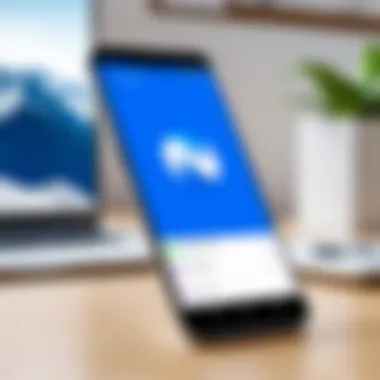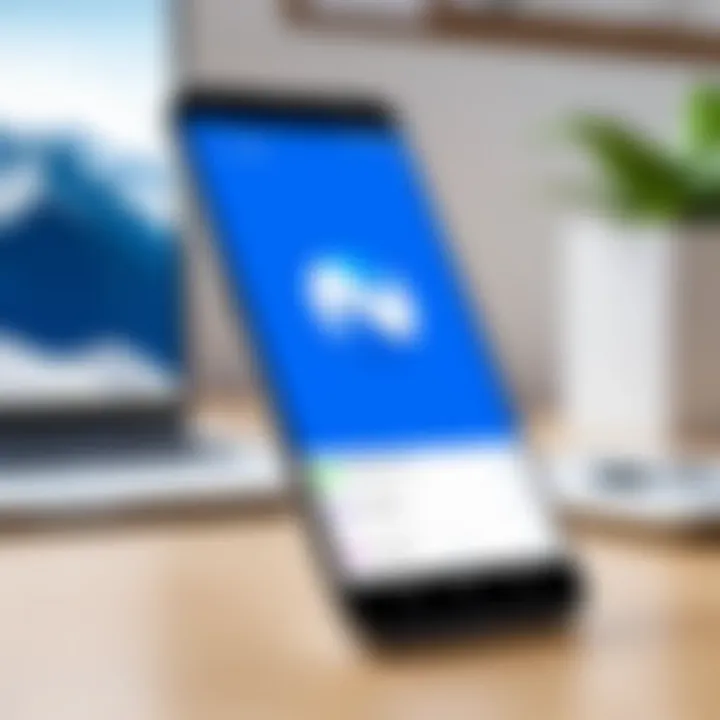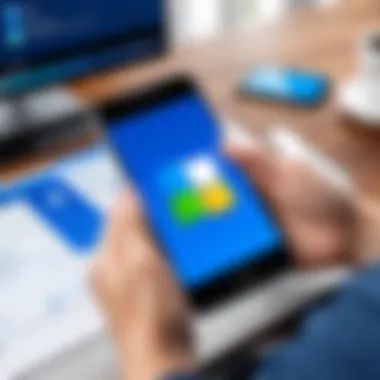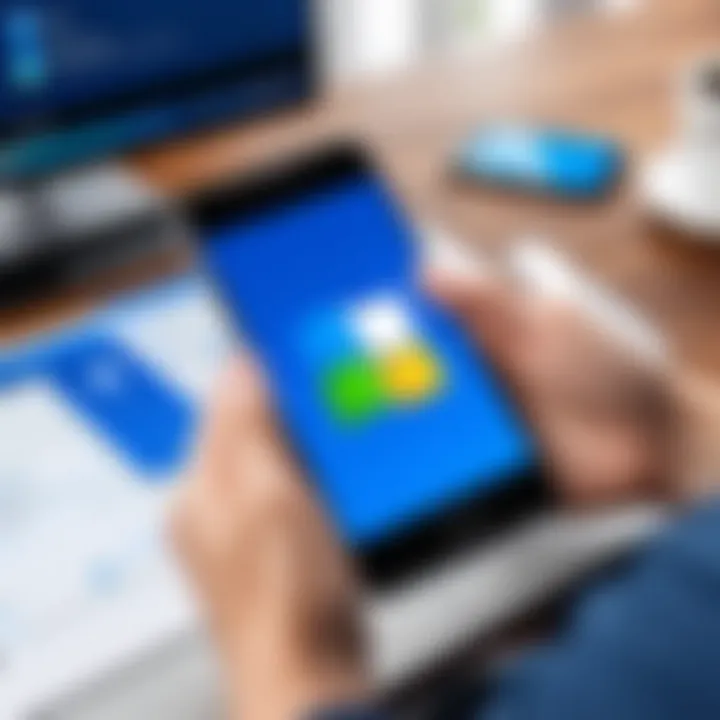Remote Control Your Android Phone with TeamViewer


Intro
In today's interconnected world, the need for effective remote control solutions has surged. TeamViewer emerges as a major player in this realm, allowing users to control Android devices from afar. This capability opens a range of possibilities for both personal use and professional scenarios. Understanding how to deploy this technology for remote access can significantly enhance productivity and user convenience.
Overview of the Technology
TeamViewer is a sophisticated remote access platform that offers various functionalities for managing devices. Its design caters to a wide array of users, supporting various operating systems, including Android. The ability to control Android phones remotely brings several key advantages.
Key specifications
- Cross-platform compatibility: Works seamlessly across Windows, macOS, and various mobile operating systems.
- High-definition display quality: Provides clear and crisp visuals during remote sessions.
- Data encryption: Ensures secure connections, protecting sensitive information from unauthorized access.
Unique selling points
The unique selling points of TeamViewer include:
- Ease of setup: Users can quickly install the application without extensive technical knowledge.
- Immediate access: Allows rapid support for troubleshooting and maintenance.
- Wide application range: Suitable for personal needs, business support, and IT management.
Design and Build Quality
The design of TeamViewer emphasizes simplicity and functionality, making it accessible to a broad audience. The layout is straightforward, allowing users to navigate without frustration.
Material used
Primarily, TeamViewer operates as software, so physical materials are not applicable. However, its system requirements include robust hardware specifications to support smooth operation. This ensures that the software runs efficiently, even on lower-end devices.
Ergonomics and usability
Usability is a critical feature of TeamViewer. The user interface is intuitive, allowing even non-expert users to understand its functions quickly. Functions such as screen sharing and file transfer are executed with minimal clicks. This focus on user experience ensures that individuals can access their devices without unnecessary complications.
"The essence of TeamViewer's success lies in its reliable performance and user-friendly design, adapting to various needs without compromise."
By harnessing the capabilities of TeamViewer, users can effectively manage Android devices from any location. This technology transforms the way individuals interact with their devices, offering unprecedented control and flexibility.
Preamble to Remote Control Technologies
Remote control technologies have become vital in today’s fast-paced digital landscape. The ability to access devices remotely increases productivity and enhances convenience, especially for users who manage multiple devices. In various sectors—business support, technical troubleshooting, and even personal device management—remote control software serves essential purposes. TeamViewer, a leading solution in this domain, exemplifies how these technologies function and their impact on everyday tasks.
Understanding Remote Control Software
To grasp the full significance of remote control technologies, one must first understand what remote control software entails. This type of application allows users to access and control a device from a distance, typically via internet connection. As technology has advanced, remote control capabilities have evolved, becoming more reliable and user-friendly.
Key components of effective remote control software include:
- Accessibility: Users can connect from various locations, eliminating the need to be physically present.
- Ease of Use: Many software options provide intuitive interfaces that require minimal training for new users.
- Security: With sensitive data often involved, remote access tools prioritize encryption and authentication measures to safeguard the user's information.
Furthermore, remote control software caters to diverse scenarios. For instance, a person working from home can access their office computer to retrieve files or install software updates. In contrast, tech support agents can assist customers by observing their screens and providing real-time instruction.
The Role of TeamViewer in Remote Access
TeamViewer stands out in the realm of remote access for its robust feature set and reliability. The software allows users to connect to any device that has TeamViewer installed, regardless of whether it's a computer, tablet, or mobile device. Not only does it support remote desktop access, but it also offers functionalities like file transfer and remote printing.
The significance of this tool extends beyond individual usage. In professional environments, TeamViewer facilitates:
- Remote Customer Support: Companies can provide immediate assistance, ensuring quicker resolutions to client issues.
- Training: Organizations can conduct training sessions with staff in various locations by demonstrating processes on shared screens.
- Collaboration: Teams can collaborate in real-time, increasing efficiency and brainstorming productivity.
"With the rise in remote work culture, understanding tools like TeamViewer is essential to maintain productivity and connectivity across various platforms."
In sum, the importance of remote control technologies in facilitating seamless interaction with devices cannot be overstated. As we delve deeper into this topic, we will explore TeamViewer’s features and applications in both personal and professional settings.
Overview of TeamViewer


Understanding TeamViewer is crucial in the context of remote control technologies, particularly for Android devices. TeamViewer serves as a comprehensive solution that facilitates remote access to Android smartphones, making it a practical tool for both personal and professional applications. By exploring its history, core features, and functionalities, one can appreciate how it streamlines the remote control process.
History and Development
TeamViewer was originally launched in 2005, evolving significantly over the years. The software started with a primary focus on remote desktop access and has gradually expanded its capabilities to include mobile access, remote support, and a range of collaborative tools. The growth of internet connectivity and mobile technology has impacted its development, pushing the software to enhance performance and usability. Today, TeamViewer has become a leading name in the field of remote access, allowing users to manage devices from virtually anywhere.
Core Features of TeamViewer
TeamViewer provides a suite of features designed to make remote interactions efficient and effective. Some of its highlights include:
Cross-Platform Access
Cross-Platform Access ensures that users can connect to various devices regardless of their operating systems. This is a key characteristic because it allows flexibility for users who might need to manage Android phones alongside other device types. Whether accessing Windows, macOS, or Linux devices, TeamViewer delivers a unified experience.
One significant benefit of this feature is the ability to support diverse environments, which means users do not have to be limited by the hardware they choose. However, there may be occasional compatibility issues that arise due to the diverse range of device configurations.
File Transfer Capabilities
The File Transfer Capabilities of TeamViewer allow users to send and receive files effortlessly between devices. This is an essential feature that enhances productivity. For instance, if a user needs to transfer a document from their Android phone to a computer, TeamViewer makes this swift and straightforward.
It stands out for its ease of use, requiring only a few clicks to execute transfers. Nevertheless, large file transfers can sometimes lead to slowdowns, depending on the network bandwidth, which is something to consider.
Remote Printing
Remote Printing is another valuable feature of TeamViewer, enabling users to print documents from their Android devices directly to a printer connected to another computer. This allows for greater convenience and accessibility, especially for users who may not have their printer directly accessible.
The key characteristic of this feature is its ability to streamline workflows, particularly in professional settings where immediate document printing might be necessary. However, users should be aware that not all printer types are supported, which may limit functionality in some cases.
In summary, TeamViewer's core features make it a strong candidate for remote control solutions. Understanding these elements helps users weigh the advantages and challenges presented by the software, leading to informed decisions about its use.
Setting Up TeamViewer on an Android Phone
Setting up TeamViewer on an Android phone is an integral step for anyone looking to take advantage of remote control capabilities. This setup not only provides convenience but also enables seamless connectivity, enhancing both personal and professional interactions. With TeamViewer, users can access their devices, perform troubleshooting, and even offer remote assistance without being physically present.
To gain maximum benefits from TeamViewer, one must carefully follow the download and installation process, followed by appropriate configuration settings. Each step contributes to a successful integration of the software into your Android system.
Downloading and Installing TeamViewer
The first step in utilizing TeamViewer on your Android phone is downloading the app from the Google Play Store.
- Open the Google Play Store on your Android device.
- In the search bar, type "TeamViewer" to locate the official application.
- Select TeamViewer from the results and tap Install.
- Once the installation is complete, find the app on your home screen or app drawer.
Installing TeamViewer is straightforward, but ensuring you download the official version is crucial. This ensures security and functionality, as unofficial versions may pose risks or lack essential features. After downloading, launch the app to begin the initial configuration.
Configuration Settings for First-Time Use
Following the installation, you must configure TeamViewer for optimal use. Open the app to find a user-friendly interface guiding you through the setup process.
- On the home screen, you will see a unique ID and password. These credentials are essential for establishing a remote connection.
- You can choose to allow the app to access specific device features such as notifications, contacts, and settings to enhance functionality.
- For those concerned about privacy, it is possible to customize access permissions.
Keep in mind that TeamViewer necessitates a stable internet connection for effective functionality. Using Wi-Fi is generally recommended to avoid disruptions during session.
Note: Always ensure you are aware of who has access to your Android device during remote sessions to maintain security.
In summary, preparing TeamViewer on your Android phone involves a few critical steps from downloading to configuring settings. This process lays a solid foundation for the effective use of remote access technology, meeting the needs of tech-savvy users.
Connecting to an Android Device
Establishing a connection to an Android device is a critical aspect of using TeamViewer effectively. It enables users to access their device remotely and manage it from anywhere. This capability is not only helpful for personal convenience but also beneficial in professional contexts. Understanding the nuances of connecting to an Android device can enhance user experience and improve functionality.
How to Establish a Remote Connection
To begin, the process of establishing a remote connection using TeamViewer on an Android device can be broken down into straightforward steps. First, ensure that TeamViewer is installed and properly configured on both the Android device and the controlling device, whether it's a computer or another mobile device. The user needs to follow these steps:


- Open TeamViewer on the Android device, which will generate a unique ID and password.
- On the controlling device, enter the provided ID in the TeamViewer application under the section for connecting to partner devices.
- Click 'Connect', then input the password when prompted.
- Once authenticated, the user will access the Android device's screen and functionalities remotely.
This streamlined process allows for quick setup, saving time and effort.
Additionally, it is important to ensure that both devices are connected to a stable internet connection to avoid interruptions. A poor network can lead to drops in connection, causing disruptions in usage.
Managing Connection Settings
After successfully establishing a remote connection, managing connection settings becomes crucial for optimizing the user experience. TeamViewer provides options to adjust settings that affect performance and usability. Users can focus on:
- Connection Quality: Depending on the network condition, adjust the quality settings. If the bandwidth is low, selecting a lower quality can improve the connection. Conversely, a high-quality setting is preferable when the network allows it.
- Remote Control Options: Enable or disable various features such as remote sound, clipboard synchronization, or resolution settings based on user needs.
- Session Recording: For professional uses, activating session recording may help in documenting interactions.
Making these adjustments ensures that the connection remains effective and tailored to specific tasks. Users should regularly revisit these settings to maximize their remote access experience.
Practical Applications of TeamViewer on Android
TeamViewer serves various significant practical applications that enhance its utility for Android users. Understanding these applications allows users to leverage the tool effectively in both personal and professional contexts. This section explores the specific uses of TeamViewer, emphasizing how it benefits users by streamlining processes, improving efficiency, and enhancing overall user experience.
Remote Customer Support
Remote customer support is one of the most valuable applications of TeamViewer on Android. Businesses can resolve client issues swiftly by accessing their customers' devices. This functionality eliminates the need for long phone conversations or tedious instruction exchanges. Support agents can see the issues directly, which helps in diagnosing problems quickly. The following are key aspects of remote customer support using TeamViewer:
- Instantaneous Assistance: Agents can connect in real-time to address client issues without unnecessary delays.
- Visual Troubleshooting: Observing the customer's screen simplifies the troubleshooting process.
- Enhanced Client Satisfaction: Quick resolutions lead to higher customer satisfaction, fostering loyalty.
- Cost-Effective Solutions: Reduces the need for in-person visits, saving time and resources.
Troubleshooting Issues
Another pivotal application of TeamViewer is its ability to troubleshoot issues effectively. Users can address software glitches, network problems, or any operational hurdles via remote access. This method is especially beneficial for tech support teams and IT professionals who manage multiple devices. Key benefits include:
- Remote Diagnostics: Support personnel can identify issues without being physically present, making it convenient and efficient.
- Reduced Downtime: Quick interventions minimize operational downtime for users, ensuring continuous workflow.
- User Empowerment: With guided support, users learn about their devices, becoming more self-sufficient over time.
Conducting Training Sessions
Conducting training sessions remotely is increasingly popular, and TeamViewer offers a robust platform for this purpose. Programs can be delivered live with the ability to share screens, making instruction more effective. Organizations can benefit in several ways:
- Interactive Learning: Participants can ask questions in real time while the trainer demonstrates features directly on the software.
- Wider Reach: Companies can operate global training programs without the need to travel, allowing them to tap into unique talents.
- Cost Savings: Reduces the expenses associated with traditional training setups.
- Following Up: Conducting follow-up sessions becomes easy to manage for continuity and reinforcement of concepts.
Utilizing TeamViewer enhances productivity and creates efficiencies. Remote assistance has become essential in our tech-driven world.
Benefits of Using TeamViewer
The use of TeamViewer for remote control of Android phones offers a variety of advantages that cater to both personal and professional users. Understanding these benefits can help users maximize the potential of this tool. The main strengths of TeamViewer lie in its security measures and user experience. These aspects are crucial for anyone considering implementing remote access technology in their daily activities. When properly utilized, TeamViewer can enhance productivity, streamline communication, and improve problem-solving capabilities.
Security Measures in Remote Access
Security plays a central role in maintaining trust and ensuring the functionality of remote access tools. TeamViewer especially emphasizes robust measures to safeguard user data and device integrity.
End-to-End Encryption
End-to-End Encryption (E2EE) is a critical aspect of digital security. TeamViewer’s E2EE ensures that data transmitted between devices remains secure from unauthorized access. The primary characteristic of E2EE is that it scrambles the data in a way that only the communicating users can decrypt it. This shared privacy makes E2EE an essential choice for safeguarding sensitive information during remote sessions.
The unique feature of TeamViewer's E2EE is how it establishes a secure channel between devices before any information is transmitted. This means that even if a hacker intercepts the data stream, they cannot read the information without the decryption key. This approach increases the overall security profile of TeamViewer, making it a popular tool for users needing secure remote access. Moreover, this reduces the risk of data breaches and unauthorized access, which are paramount in today’s increasingly digital world.
Two-Factor Authentication
Two-Factor Authentication (2FA) adds another layer of security to remote connections. This method requires users to provide two forms of authentication before accessing their devices. The key characteristic of 2FA is that it significantly lowers the risk of unauthorized access by adding an extra step to the login process. It is a beneficial choice for anyone concerned about the integrity of their data and devices.
The unique feature of TeamViewer’s implementation of 2FA is its flexibility. Users can set up 2FA using their mobile devices or reliable authentication apps. This adaptability ensures that users can maintain a consistent level of security regardless of their location or device used. However, while 2FA does enhance security, it may also lead to inconvenience if users forget their second authentication method. Thus, balancing convenience with security is important in this context.
User Experience and Accessibility
The experience of using TeamViewer is designed to be straightforward and user-friendly. A clean interface allows users to navigate features with relative ease, ensuring that technical proficiency is not a barrier to effective remote control. Accessibility is another key benefit, as TeamViewer ensures that users can connect to their devices from anywhere, making it an ideal solution for those on the go or working remotely.
TeamViewer is compatible with a range of devices, fulfilling different user needs. This cross-platform nature ensures a smooth experience, regardless of whether the user is operating on an Android phone, Windows PC, or another system. Such wide compatibility ultimately democratizes the utility of remote control technology, making it accessible to a broader audience.


In summary, the benefits of using TeamViewer for remote control of Android devices include robust security measures like End-to-End Encryption and Two-Factor Authentication. Coupled with an intuitive user experience, it offers a comprehensive solution. As technology continues to evolve, TeamViewer seems positioned to adapt and address the ever-changing needs of its users.
Limitations and Challenges
Understanding the limitations and challenges associated with TeamViewer's remote control capabilities for Android devices is crucial. It allows users to set realistic expectations and address potential issues in effectively utilizing the software. While TeamViewer provides many benefits, certain drawbacks can impact the user experience and effectiveness of remote access.
Network Dependency
One primary limitation of using TeamViewer is its dependence on a reliable internet connection. The performance and efficiency of remote control activities hinge on both the host and remote devices being connected to the internet. This means that users in areas with weak connectivity may experience interruptions or degraded performance during remote sessions.
In Wi-Fi environments, fluctuations can lead to disconnections, making it difficult to maintain a stable control session. Conversely, using mobile data can mitigate some of these issues, but results in higher data consumption, which can be costly. Ensuring an optimal network setup is imperative for a smooth experience. In preparation for a remote session, users should verify their network reliability.
Potential Latency Issues
Latency is another significant challenge in remote control scenarios. Latency refers to the delay between the user's action and the corresponding response on the remote device. High latency can lead to frustrating experiences, especially when precision control is necessary.
TeamViewer users may encounter latency due to various factors:
- Geographic distance between devices
- Network congestion
- Device performance limitations
To help minimize latency, users should select servers that are geographically closer and avoid concurrent high-bandwidth activities on the same network.
Compatibility Considerations
Compatibility is a vital aspect to consider when using TeamViewer. While the application supports a variety of devices and operating systems, certain limitations can arise. Not all Android phones support the latest updates or features of TeamViewer, leading to inconsistencies in functionality.
Moreover, some Android versions may have restrictions that limit the app's capabilities, affecting features such as screen sharing or file transfers. Users should be aware of their device's compatibility with TeamViewer to avoid functionality issues. Before installing TeamViewer, it is advisable to consult the official compatibility guidelines
Future Outlook of Remote Access Technologies
The landscape of remote access technologies is evolving rapidly. As we look ahead, understanding these advancements is crucial for users, developers, and organizations alike. The importance lies in recognizing how these technologies will influence efficiency, productivity, and security in remote operations.
The future of remote access technologies is marked by several key elements. First, there is an increasing emphasis on user-friendly interfaces. As more individuals utilize these tools for personal and professional needs, the demand for intuitive design is growing. This focus ensures that even non-technical users can navigate complexities with greater ease.
Moreover, security continues to be a paramount concern. With widespread adoption, threats have become more sophisticated. The integration of advanced security features will be essential. This includes implementing robust encryption protocols and improved authentication methods to safeguard sensitive information during remote sessions.
Another significant consideration is the increasing reliance on cloud-based solutions. These platforms allow easy access from various devices and locations. As mobile technology continues to expand, the necessity for efficient cloud integration becomes even more pressing.
In summary, the future outlook highlights a combination of usability, security, and cloud integration as vital components shaping remote access technologies. These factors are fundamental to enhancing how people interact with their devices over distance.
Emerging Trends in Remote Control
The emergence of artificial intelligence is significantly altering the remote control landscape. These AI systems are capable of analyzing user behavior, which leads to tailored experiences. Adaptability in features helps users maximize productivity, ultimately advancing remote support and control.
Another trend is the rise of remote collaborations across teams. As remote work becomes normalized, tools are being developed to enable seamless interaction. Features such as real-time screen sharing and joint control are becoming standard. This integration enhances teamwork and allows colleagues to assist each other effectively.
Additionally, Internet of Things (IoT) devices are on the rise. These devices can be remotely managed, allowing users to access and control them through mobile platforms. As more smart devices enter households and workplaces, the ability to remotely manage them will only expand.
Predicted Developments for TeamViewer
Regarding TeamViewer, several predictions emerge. Firstly, an extended focus on integration with augmented reality (AR) and virtual reality (VR) technologies is expected. As these technologies become mainstream, TeamViewer can expand its offerings, allowing users to perform tasks in a more immersive environment. This advance could improve troubleshooting and training sessions for users.
Moreover, it's plausible that TeamViewer will enhance its collaboration tools further. Inviting a multi-user experience may be a critical step for the platform. This enhancement would facilitate team collaboration, resulting in greater efficiency and quicker problem resolution.
Additionally, advancements in automation and machine learning could influence TeamViewer's capabilities. By automating routine tasks, users may experience increased productivity and a more streamlined workflow. With these developments, TeamViewer aims to remain at the forefront of remote access technologies.
Culmination
In this article, we have explored the nuances of using TeamViewer for the remote control of Android phones. This topic is significant due to the increasing reliance on technology in both personal and professional settings. TeamViewer offers a comprehensive solution that addresses the needs for remote access and troubleshooting in real time.
Summary of Key Insights
Understanding the functionalities of TeamViewer reveals several critical insights:
- Accessibility: TeamViewer allows users to control their Android devices from virtually anywhere. This flexibility is invaluable for many users, from tech support teams to individuals managing multiple devices.
- Security Protocols: The platform ensures secure connections through end-to-end encryption and two-factor authentication. This is of utmost importance given the growing concerns regarding data privacy and security.
- Versatility in Applications: The diverse applications of TeamViewer, such as remote support and training, expand its usability. It adapts well to various scenarios, making it a favored choice among professionals.
Final Thoughts on TeamViewer's Usefulness
Reflecting on the discussion above, TeamViewer stands out as a practical tool for managing Android devices remotely. Its ease of use and advanced features cater to a wide range of users and situations. The software empowers both individuals and businesses to handle issues without being physically present, promoting efficiency and productivity.







